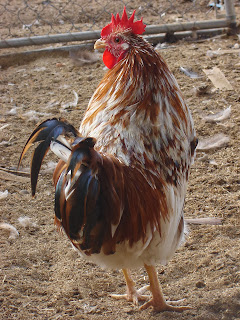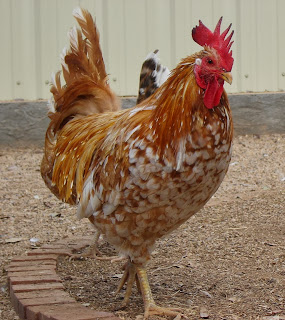Since I'm on a roll, I'm going to go ahead and cover the other breeder pen that I'm setting up right now. I still need to move a few hens around, but at least I can describe what the goals are.
First, the rooster. I believe he is 3/4 Swedish Flower. He looks very much like a pure Swedish, as you can see. So why do I not think he's pure?
A few reasons, one, he's a bit smaller than his pure Swedish father, though just barely. He still towers over the old-style tiny Aloha hens.
Mostly, I don't think he's pure Swedish, because of how he looked as a chick. Today he shows little mottling, which is a huge letdown. But there is something else going on there, because as a chick, he showed MORE WHITE than about anything I'd ever seen! Can you believe THIS is how he looked as a baby?
 |
| No, not kidding. Same chick. |
 |
| Still the same chick. About 4-6 weeks later. |
 |
| Well, he is tall at least. Half Sussex hen beside him. She's pretty big. |
He looked very Aloha as a chick, but now that he's grown, I would say he would easily pass for a pure Swedish Flower rooster. I had some half-Aloha, half Swedish hens in with a pure Swedish rooster last year, so it is very possible that this fellow is the result. I am hoping that the little bit of 25% Aloha blood will pop out some new colors in his babies, when crossed back to the teeny little colorful hens in the pen with him. Worth a shot.
Here are some of the ridiculously small but vividly colored Aloha hens in with him:
 |
| Love this hen's color. Wish she had the size to go with it. |
 |
| So colorful. So ridiculously small. |
I have kept these colorful little hens, despite their off colored legs and small size, because they are tough heat tolerant, disease resistant survivors with gorgeous colors. But they are 2+ years now, so I have to think about breeding replacements. Even small sized replacements. Just to keep the pretty color. I have noticed these older hens don't lay as prolifically as they used to!
Here's another NEW hen that is the same (tiny) size as the original Alohas, At least we are getting hens with yellow legs now!
Some of the hens are mid-size. They are in-between the tiny first generation, but not as big as the half Swedish and half Sussex crosses. These hens were created by crossing a NHR to a Vanilla daughter, and taking the son from that cross, and putting him with little Aloha hens. So they are about 3/4 Aloha and 1/4 NHR. The improved size does carry through, to some degree. I wonder what they will produce with this (mostly Swedish) rooster?
I have three of these "in between" hens that are mostly Aloha. I also have a few ???? hens that I'm not sure of the pedigree. Not as white as the little Alohas, not as big as the half Swedish. In other words, I have no idea which cross made these hens:
Sussex? Swedish? New Hamshire? Buff Rock? It could be any or all of these breeds, plus a healthy dose of Aloha. Your guess is as good as mine! They aren't quite as tiny as the smallest hens, but not nearly as big as the half Swedish or half Sussex.
One half Sussex is particularly stunning:
Of all the hens, her chicks could be the ones to watch from this cross. She is Sussex/Aloha with no Swedish. I know that because I've had her since before I got the Swedish Flower Hens. Here she is from a while back - last year I think.
The fact that she is still here, and as you can see in the first photo taken today, still very healthy despite the grueling summer temps, is really encouraging.
Right now, there are just too many hens in there in general, until I get the pen sorted and some of the other hens shuffled to other areas, and maybe cull a few more. However, this is kind of the general program for this breeder pen, cross the big rooster with the small and really colorful hens.
Sussex? Swedish? New Hamshire? Buff Rock? It could be any or all of these breeds, plus a healthy dose of Aloha. Your guess is as good as mine! They aren't quite as tiny as the smallest hens, but not nearly as big as the half Swedish or half Sussex.
One half Sussex is particularly stunning:
 |
| Current picture |
Of all the hens, her chicks could be the ones to watch from this cross. She is Sussex/Aloha with no Swedish. I know that because I've had her since before I got the Swedish Flower Hens. Here she is from a while back - last year I think.
 |
| Older photo of same hen. |
Right now, there are just too many hens in there in general, until I get the pen sorted and some of the other hens shuffled to other areas, and maybe cull a few more. However, this is kind of the general program for this breeder pen, cross the big rooster with the small and really colorful hens.
 |
| Some of my oldest little Aloha hens! |










































